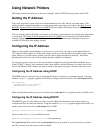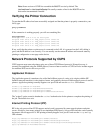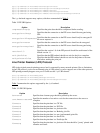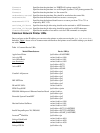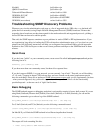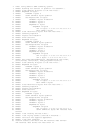
Dissecting the Output
The first two lines are just informational and let you know that the default community name and address are
being used. Lines 3-15 contain the initial SNMP query for the device type OID (.1.3.6.1.2.1.25.3.2.1.2.1) from
the Host MIB.
Lines 16-31 show the response we got from an HP LaserJet 4000 network printer. At this point we discover
that it is a printer device and then send another SNMP query (lines 32-43) for the device description OID
(.1.3.6.1.2.1.25.3.2.1.3.1) from the Host MIB as well.
Lines 44-58 show the response to the device description query, which tells us that this is an HP LaserJet 4000
Series printer.
On line 59 we start our active connection probe and discover that this print server supports the AppSocket
(JetDirect) protocol on port 9100.
Finally, line 63 shows the device information line for the print server that is sent to CUPS.
Reporting Problems
If you don't see your printer listed, or the wrong information is listed, then you need to gather more
information on the printer. The easiest way to do this is to run the snmpwalk command:
snmpwalk -Cc -v 1 -c public ip-address | tee snmpwalk.log
where "ip-address" is the IP address of the printer or print server. You should see a lot of values stream by -
the ones you want to see are:
HOST-RESOURCES-MIB::hrDeviceType.1 = OID: HOST-RESOURCES-TYPES::hrDevicePrinter
HOST-RESOURCES-MIB::hrDeviceDescr.1 = STRING: HP LaserJet 4000 Series
The hrDeviceType line should show hrDevicePrinter; if not, then your printer or print server doesn't identify
itself as a printer. The hrDeviceDescr line should provide a human-readable string for the make and model of
the printer, although in some cases you'll just see something less useful like "Axis OfficeBASIC Parallel Print
Server".
Once you have collected the snmpwalk output, you should go to the CUPS Bugs & Features page to submit a
feature request to support your printer or print server. Be sure to attach those two log files you created - they
will help us to identify the SNMP values we need to look for.
Configuring Print Servers
Configuring Axis Print Servers
The Axis print servers can be configured using BOOTP or DHCP. However, on models that do not provide
IPP support an additional step must be performed to configure the TCP/IP portion of the print server for use
with CUPS.
Each print server contains a configuration file named config that contains a list of network parameters used by
the server. To modify this file you must first download it from the print server using the ftp(1) program:
ftp ip-address
Connected to ip-address.
220 Axis NPS ### FTP Printer Server V#.## MON DD YEAR ready.



